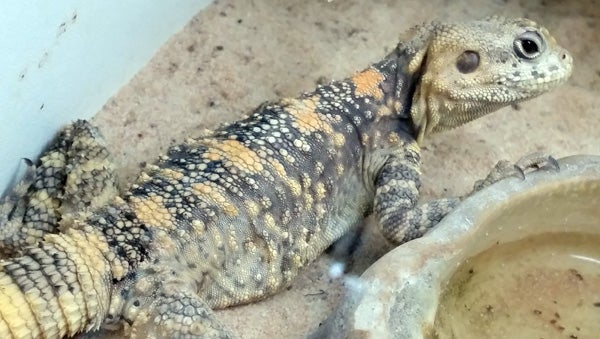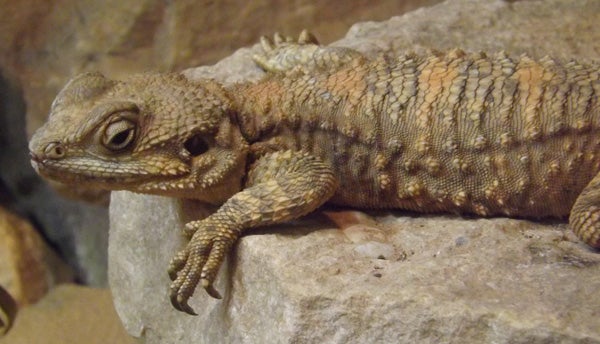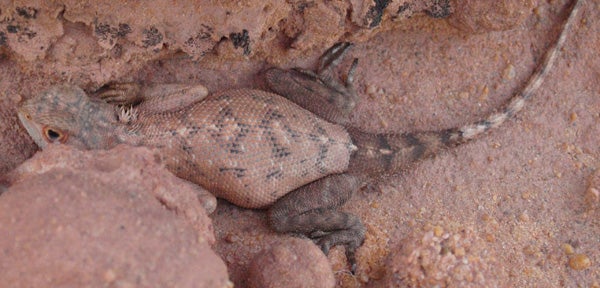This article was published in Scientific American’s former blog network and reflects the views of the author, not necessarily those of Scientific American
I tend to think of agamids as a group I’ve covered fairly recently here at Tet Zoo. Errm, no, not true – I think the last time I covered them at any length was 2006 or something. Anyway, today we’re going to look very briefly at a lizard that belongs to one of my favourite groups: the species is Stellagama stellio, and it is of course a species of Agamidae, the agama family. S. stellio goes by many common names (among them Stellion, Hardun, Starred agama and Sling-tailed agama), but the most familiar is the evocative Rainbow dragon.

Captive Stellagama, apparently of the subspecies S. s. brachydactyla (as are most individuals seen in captivity). Credit: Darren Naish
We’ll begin with my usual tedious lament: that I simply can’t blog about the more obscure species in this group because I can’t get images of them. If you know agamids, you’ll surely have seen S. stellio in captivity, if not in the wild (it occurs in northwest Africa, southwestern Asia and Greece). It reaches 35 cm in total length, is associated with rocky habitats, takes refuge in crevices, and is frequently seen basking on rocks, trees and stone walls. It has some ability to change colour, this varying according to temperature and mood, and is at least partly herbivorous.
On supporting science journalism
If you're enjoying this article, consider supporting our award-winning journalism by subscribing. By purchasing a subscription you are helping to ensure the future of impactful stories about the discoveries and ideas shaping our world today.

Another captive Stellagama: an older, darker, larger individual than the one shown above. The scales on the tails of these lizards are arranged in distinct segments of paired whorls, though the segments contain three whorls at the end of the tail. Credit: Darren Naish
Like me, you might be used to thinking of this species as a member of the large (c 20 species) agamid genus Laudakia, and this is where most reference works still place it. Prior to about 1980, Laudakia was merged with Agama, and the raising of Laudakia out of Agama was one thing I wrote about here (well, at ver 1) in 2006. It has, however, been thought for a while – at least among some specialists – that Laudakia of tradition is paraphyletic, some species (the ‘L. caucasica group’) being closer to toad-headed agamas (Phrynocephalus) than others (Macey et al. 2000). This was acted upon by Baig et al. (2012) who erected Stellagama for stellio and Paralaudakia for caucasius. So, goodbye Laudakia stellio, hello Stellagama stellio.

Those nostrils are interesting. The ears are interesting. The raised tubercles on the flanks are interesting. The claws are interesting. You know -- lizards are just really interesting. This is another captive individual of S. s. brachydactyla. Credit: Darren Naish
S. stellio is well known for being polytypic: that is, for including several populations that are regarded as distinct taxa, in this case ‘subspecies’. Of the seven or so subspecies recognised in S. stellio, a few are relatively recently named (namely S. s. cyprica, named 1967; S. s. daani, named 1980; and S. s. salehi, named 2006), though not all of these taxa are recognised by all authors (S. s. daani is not universally accepted as valid, for example). Most of the others are obviously distinct, however, and – as is typical with such species – there are suspicions that some might really be ‘distinct enough’ to warrant recognition as species on their own. Indeed, S. stellio as currently recognised might well be a species complex.

A mystery Saharan agama to identify. It should actually be pretty easy. Credit: Darren Naish
And that’s your agama fix for now: we’ll no doubt revisit them sometime within the next ten years. Until then – what, exactly, is this agamid, encountered in the wild in the Sahara Desert in Morocco? Oh, this article had its genesis in a rather more ambitious plan to write an article about the current shape of lizard phylogeny -- that’s something that’s coming soon, time permitting. It utilises content produced for The Big Book, a project which would (hint hint) greatly benefit from your kind support...
For previous Tet Zoo article on agamas and other iguanian lizards, see...
Harduns and toad-heads; a tale of arenicoly and over-looked convergence
The Squamozoic actually happened (kind of): giant herbivorous lizards in the Paleogene
Australia, land of dragons (by which I mean: agamids) (part I)
By the Horns of Trioceros, the Casque of Calumma, the Brood of Bradypodion--Chameleons, Part 2
Palleon, Archaius, Kinyongia, Nadzikambia--The Last Chameleons, Part 3
Refs - -
Baig, K. J., Wagner, P., Ananjeva, N. B. & Bohme, W. 2012. A morphology-based taxonomic revision of Laudakia Gray, 1845 (Squamata: Agamidae). Vertebrate Zoology 62, 213-260.
Macey, J. R., Schulte, J. A., Kami, H. G., Ananjeva, N. B., Larson, A. & Papenfuss, T. J. 2000. Testing hypotheses for vicariant separation in the agamid lizard Laudakia caucasia from mountain ranges of the Northern Iranian plateau. Molecular Phylogenetics and Evolution 14, 479-483.